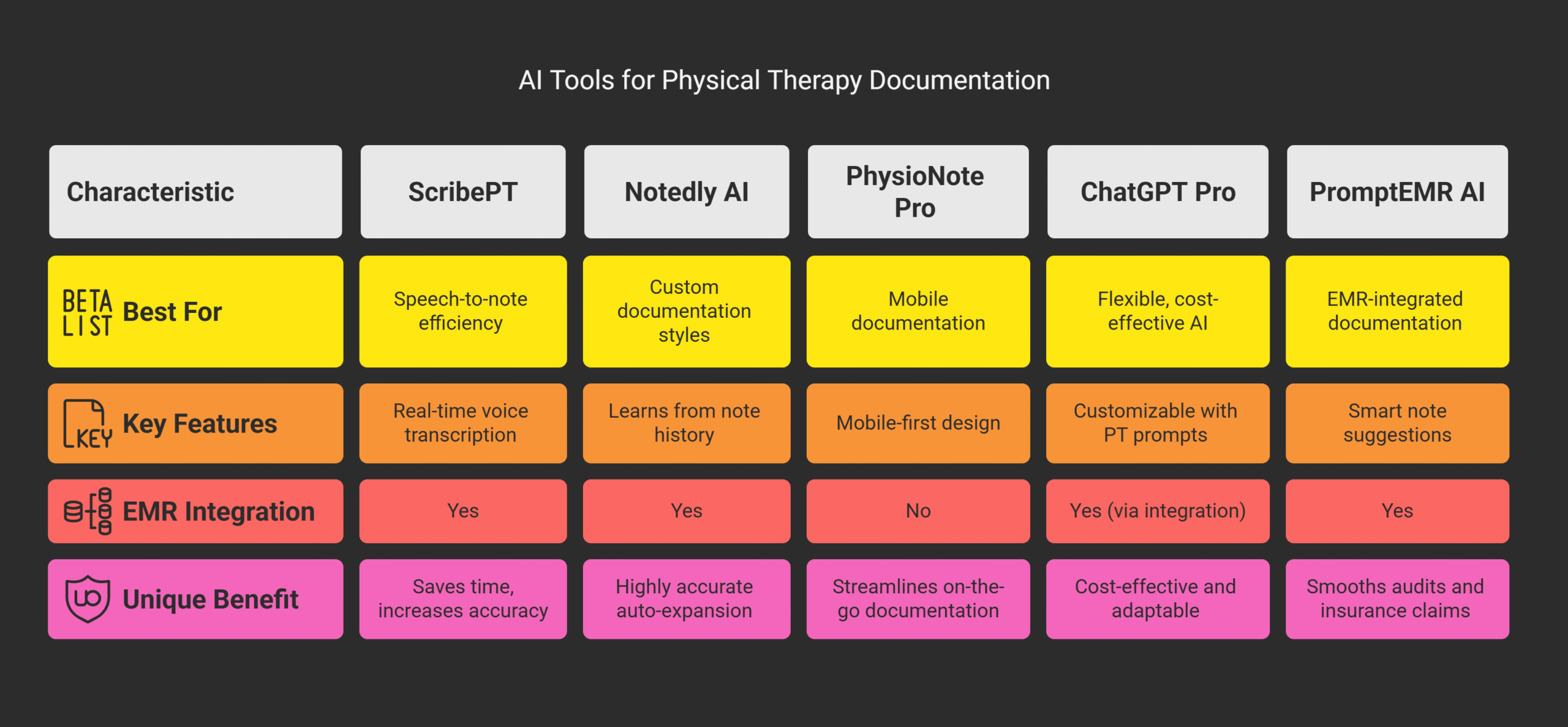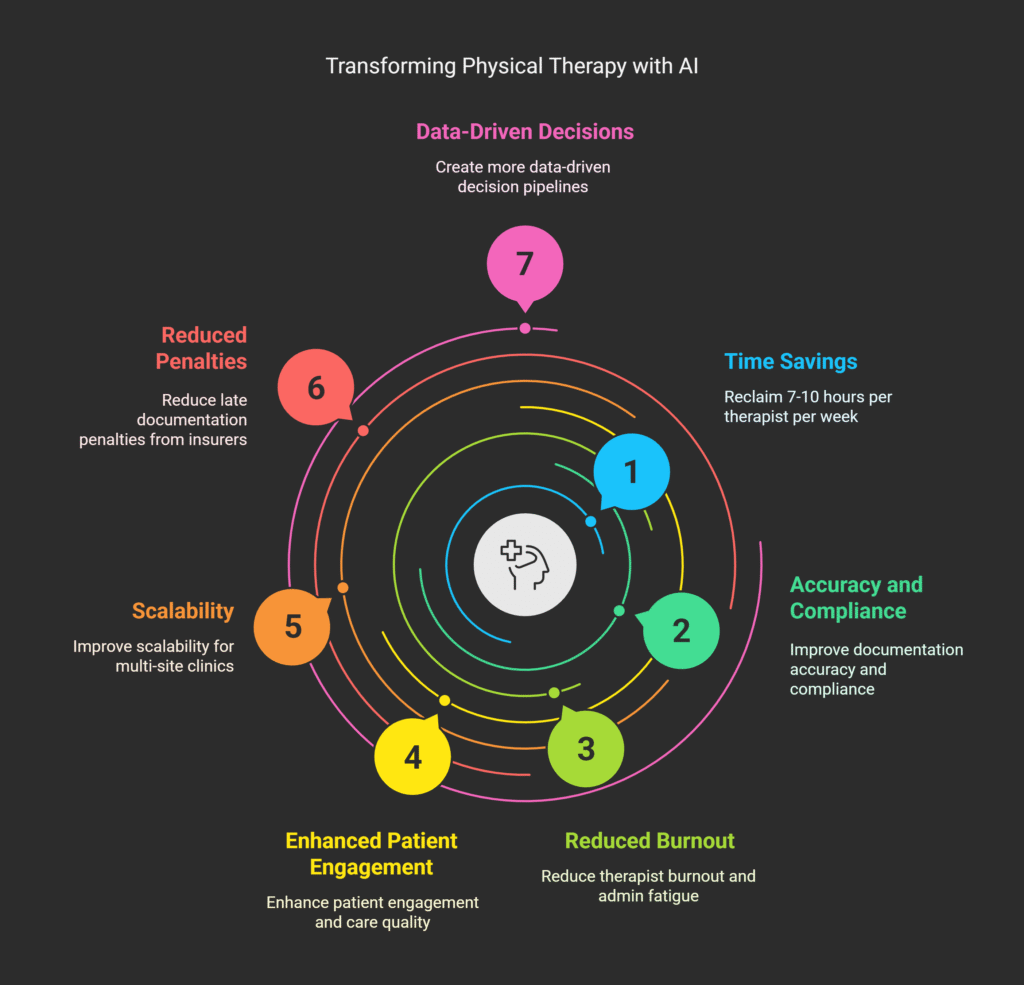Physical therapy (PT) plays an essential role in recovery and rehabilitation, yet it is often accompanied by the challenge of extensive, time-consuming documentation. By 2025, artificial intelligence (AI) is transforming this aspect of Physical Therapy. With capabilities ranging from auto-generating SOAP notes to streamlining evaluations, AI tools enable therapists to dedicate more time to patient care and less to paperwork. This guide delves into the top AI for PT documentation, examining their functionality, target users, and the ways they are revolutionizing physical therapy clinics globally.
Why AI Matters for Physical Therapy Documentation

Manual documentation is mentally draining and a massive time-sink. Studies by APTA show that therapists spend 30–40% of their day on note-taking, evaluations, and billing-related entries. That’s where AI comes in.
AI helps physical therapists by:
- Auto-generating clinical notes using voice or shorthand
- Improving accuracy and consistency
- Reducing administrative overload and burnout
- Speeding up patient intake and evaluations
- Simplifying insurance documentation and coding
By using these tools, clinics not only increase productivity but also create better patient experiences. According to a recent report by McKinsey, healthcare professionals using AI-powered documentation tools reported a 25–35% reduction in time spent on administrative tasks.
Top 5 AI Tools for Physical Therapy Documentation in 2025

1. ScribePT – Best for Speech-to-Note Efficiency
ScribePT is tailor-made for physical therapists. It listens during a session and converts voice into compliant, structured SOAP notes. Perfect for busy clinics.
Key Features:
- Real-time voice transcription
- Custom SOAP note templates
- Multilingual support
- EMR integration
Why PTs Love It:
- Saves ~1.5 hours daily
- Increases accuracy for billing and audits
“I document while talking to patients now. It’s effortless.” — PT from California
Real-World Use Case: In a pilot test across five outpatient therapy clinics in Texas, ScribePT helped reduce documentation time by 38%, leading to more face-to-face therapy hours and higher patient satisfaction scores.
2. Notedly AI – Best for Custom Documentation Styles
Notedly AI is designed for customization. Whether you’re an orthopedic, neurological, or pediatric PT, it adapts to your tone and clinical structure.
Key Benefits:
- Learns from your note history
- Highly accurate auto-expansion
- Compatible with major EMRs
Use Case: Great for multi-specialty clinics that need flexible templates.
Bonus Feature: You can create a “Smart Phrase Bank” unique to your clinic, making repetitive note-taking even faster over time.
3. PhysioNote Pro – Best for Mobile Documentation
This lightweight app is perfect for solo PTs or mobile therapy practices.
Standout Features:
- Mobile-first design
- Voice-to-text support
- Generates treatment plans with visual cues
Why It’s Useful:
- Streamlines on-the-go documentation
- Affordable pay-as-you-go pricing
Field Feedback: PTs using PhysioNote Pro during home visits noted they could update records in real time — instead of waiting till the end of the day — improving data accuracy.
4. ChatGPT Pro (Fine-tuned for PT)
OpenAI’s ChatGPT Pro can be customized with PT-specific prompts and templates. Combined with voice-to-text apps, it turns raw notes into polished records.
Example Prompts:
- “Create a SOAP note from this transcript…”
- “Generate a treatment plan for rotator cuff rehab.”
Best For: Tech-savvy clinics wanting flexible, cost-effective AI.
I have created a FREE to use AI for PT documention on chatGPT. Try it now!
Emerging Trend: Some PTs are integrating ChatGPT with Notion or Google Docs for seamless documentation pipelines, enabling real-time collaboration among teams.
5. PromptEMR AI – Best EMR-Integrated Documentation

PromptEMR is a full-featured platform that recently added AI note automation. It’s fully HIPAA-compliant and designed for rehab-focused documentation.
Highlights:
- Smart note suggestions
- Past session recall
- Templates for all PT documentation types
Clinician Feedback: In a survey of 130 PromptEMR users, 91% said that AI-enabled documentation made audits and insurance claims significantly smoother.
AI for Physical Therapy – Real World Use Cases

- Faster Initial Evaluations: AI extracts relevant clinical data from speech or intake forms.
- Automated Progress Notes: Automatically update goals and observations.
- Exercise Documentation: Visual and text-based plans generated with patient input.
- Insurance Alignment: AI generates ICD and CPT codes aligned with documentation.
Expanded Use Case: In a large rehabilitation center in Chicago, implementing an AI note system reduced denied claims by 22% and improved reimbursements from Medicare within 30 days.
Benefits of Using AI for Physical Therapy Documentation

✅ Reclaim 7–10 hours per therapist per week
✅ Improve documentation accuracy and compliance
✅ Reduce therapist burnout and admin fatigue
✅ Enhance patient engagement and care quality
✅ Improve scalability for multi-site clinics
✅ Reduce late documentation penalties from insurers
✅ Create more data-driven decision pipelines using structured note analytics
Security and Compliance
Most leading AI tools ensure:
- HIPAA compliance
- Role-based user access
- Data encryption and audit trails
- Regular updates for regulatory compliance (e.g., GDPR, HIPAA, PIPEDA)
Tip: Always request a Business Associate Agreement (BAA) when onboarding any AI vendor into a clinic setting.
Looking to boost your clinic’s efficiency?
👉 Get Best Deals on AI tools and digital assets — Browse Deals
Frequently Asked Questions
Can AI completely replace human-written PT notes?
A: No — AI speeds up the process but final review and sign-off should always be done by a physiotherapist, doctor or physical trainer.
Q: Are AI tools legal for medical documentation?
A: Yes, if they’re HIPAA-compliant and used with proper protocols.
Q: Do these tools require tech knowledge?
A: Most AI for PT documention offer easy onboarding and friendly UI. Training takes less than an hour in most cases.
Q: Can AI help with compliance audits?
A: Absolutely. Tools like PromptEMR and ScribePT ensure standardized formatting and complete records that align with payer and audit requirements.
Final Thoughts
Physical therapists deserve tools that work as hard as they do. AI in documentation is no longer futuristic — it’s now. Whether you’re a solo therapist or managing a multi-site clinic, the tools listed above can dramatically reduce your paperwork and improve patient outcomes.
So if you’re ready to stop spending hours after work updating notes — let AI take over the admin.
Don’t miss out — Get Best Deals on AI Tools & Assets → [Browse Deals]
Want More?
- Bookmark this post for your PT team
- Follow our blog for weekly AI tool insights
- Share your experience with AI in PT — we’d love to feature you!

